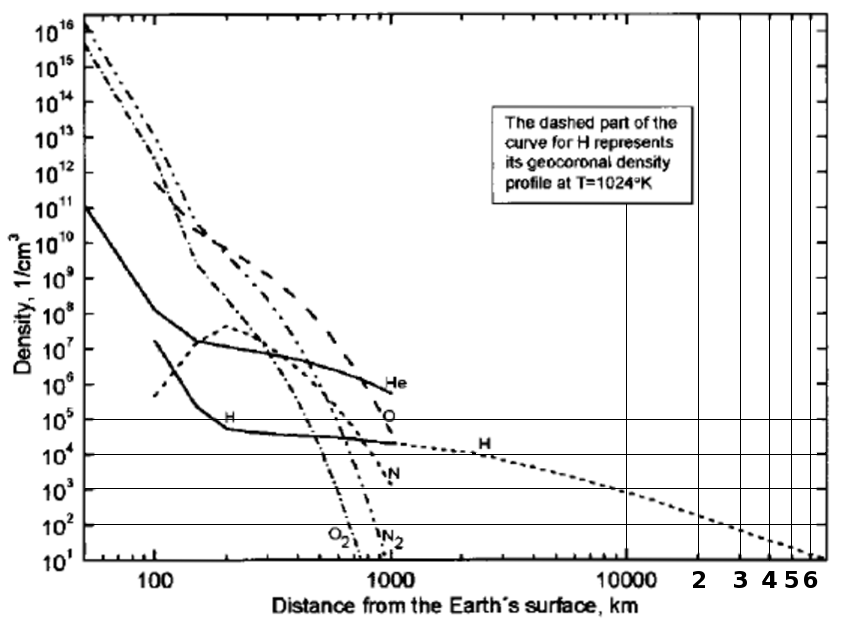|
Size: 3322
Comment:
|
Size: 3334
Comment:
|
| Deletions are marked like this. | Additions are marked like this. |
| Line 34: | Line 34: |
| Note: 75950 km radius is the apogee of a "24 hour" geosynchronous (but NOT geostationary) orbit with a 8378 km radius (2000 km equatorial altitude) perigee. The same 42164 km semimajor axis as a circular geostationary orbit. This is a High Eccentricity Earth Orbit (HEEO), suggested by space scientist John Lewis at the University of Arizona. Given the high perigee velocity of a launch loop, this orbit is easier to achieve with much less apogee insertion ΔV than a GEO orbit. The perigee velocity of this HEEO orbit is high, and that is an excellent place for a high ΔV thrust into an interplanetary orbit. Subnote: due to the J₂ nonlinearity of the Earth's gravity field, this orbit will precess, so an exact synchronous orbit will have a slightly smaller semimajor axis. | '''Note:''' 75950 km radius is the apogee of a "24 hour" geosynchronous (but NOT geostationary) orbit with a 8378 km radius (2000 km equatorial altitude) perigee. The same 42164 km semimajor axis as a circular geostationary orbit. This is a High Eccentricity Earth Orbit (HEEO), suggested by space scientist John Lewis at the University of Arizona. Given the high perigee velocity of a launch loop, this orbit is easier to achieve with much less apogee insertion ΔV than a GEO orbit. The perigee velocity of this HEEO orbit is high, and that is an excellent place for a high ΔV thrust into an interplanetary orbit. '''Subnote:''' due to the J₂ nonlinearity of the Earth's gravity field, this orbit will precess, so an exact synchronous orbit will have a slightly smaller semimajor axis. |
Propellant Plume Gas Scattering
H density versus altitude
|
alt km |
radius km |
#/m3 |
1000 |
7378 |
21000e6 |
|
2000 |
8378 |
12000e6 |
Constr. perigee |
5000 |
11378 |
3100e6 |
|
10000 |
16378 |
820e6 |
|
20000 |
26378 |
180e6 |
|
30000 |
36378 |
67e6 |
|
35786 |
42164 |
45e6 |
GEO circular |
40000 |
46378 |
35e6 |
|
50000 |
56378 |
22e6 |
|
60000 |
66378 |
14e6 |
|
69572 |
75950 |
11e6 |
Constr. apogee |
70000 |
76378 |
10e6 |
|
. https://www.sciencedirect.com/science/article/pii/0022407372900052
Estimated hydrogen mass per 1000 km height, 1.67e-27kg/H |
|||||||||||
Altitude km |
1000 |
2000 |
10000 |
20000 |
30000 |
35786* |
40000 |
50000 |
60000 |
69572* |
70000 |
Radius km |
7378 |
11378 |
16378 |
26378 |
36378 |
42164* |
46378 |
56378 |
66378 |
75950* |
76378 |
Volume km³ |
6.8e11 |
1.6e12 |
3.4e12 |
8.7e12 |
1.7e13 |
2.2e13 |
2.7e13 |
4.0e13 |
5.5e13 |
7.2e13 |
7.3e13 |
#H / m³ |
2.1e10 |
1.2e10 |
8.2e8 |
1.8e8 |
6.7e7 |
4.5e7 |
3.5e7 |
2.2e7 |
1.4e7 |
1.1e7 |
1.0e7 |
H kg |
240000 |
32000 |
4700 |
2600 |
1900 |
1700* |
1000 |
1500 |
1300 |
1300* |
1200 |
Less than 20 tonnes of hydrogen (and almost nothing else) above GEO, out to the bow shock.
Note: 75950 km radius is the apogee of a "24 hour" geosynchronous (but NOT geostationary) orbit with a 8378 km radius (2000 km equatorial altitude) perigee. The same 42164 km semimajor axis as a circular geostationary orbit. This is a High Eccentricity Earth Orbit (HEEO), suggested by space scientist John Lewis at the University of Arizona. Given the high perigee velocity of a launch loop, this orbit is easier to achieve with much less apogee insertion ΔV than a GEO orbit. The perigee velocity of this HEEO orbit is high, and that is an excellent place for a high ΔV thrust into an interplanetary orbit. Subnote: due to the J₂ nonlinearity of the Earth's gravity field, this orbit will precess, so an exact synchronous orbit will have a slightly smaller semimajor axis.
Collision cross section table
Gas |
(nm)² |
(nm)² with H₂ |
H₂ |
0.27 |
1.02 |
He |
0.21 |
0.99 |
Ar |
0.36 |
1.06 |
O₂ |
0.40 |
1.07 |
N₂ |
0.43 |
1.08 |
CH₄ |
0.46 |
1.09 |
CO₂ |
0.52 |
1.11 |
Cl₂ |
0.93 |
1.22 |
The second column is the combined collision cross section with an H₂ molecule ... the square of the sum of the square roots.
from libretexts
http://hitran.org . . . . . . . . . k*l at k*l dot com on kao3

